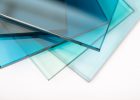When selecting a glass table top for dining tables, desks & shelving, it’s important to understand the types of glass available and their properties. This guide will address common questions and provide relevant information to help you make an informed decision.
Q: Is it necessary for the table top to be made from toughened glass?
A: Yes, it is highly recommended that the table top is made from toughened glass. This type of glass is significantly stronger and safer than regular glass, making it ideal for dining tables where durability and safety are paramount.
Q: What is the difference between toughened and tempered glass?
A: Toughened and tempered glass refers to the same type of glass. The process was first developed by chemist Rudolph A. Seiden in Australia around 1905. During this process, glass is heated until it nearly liquefies and then rapidly cooled, which changes its internal structure and significantly increases its strength by a factor of about 10.
Q: Can toughened glass be coloured or tinted?
A: Yes, both clear and tinted glass can be toughened. Additionally, glass can be painted or lacquered after the toughening process to achieve a variety of colours.
Q: Can toughened glass be cut to size after it has been tempered?
A: No, toughened glass cannot be cut or altered after the tempering process, as this will cause it to shatter. It’s crucial to have the glass cut to the desired size before it is toughened.
Q: How much stronger is toughened glass compared to regular glass?
A: Toughened glass is approximately 8-10 times stronger than standard glass. This increased strength makes it more resistant to impact and thermal stress, reducing the likelihood of breakage.
Q: Is toughened glass the same as safety or laminated glass?
A: No, they are different. Toughened glass is a single sheet of strengthened glass. Laminated glass, on the other hand, consists of two layers of glass with a resin interlayer that holds the glass together even if it breaks, providing an additional level of safety.
Q: How can I tell if my glass is toughened?
A: Toughened glass will have a European standard EN code etched into it, indicating that it meets specific safety and quality standards.
Q: Is curved glass toughened?
A: Typically, curved glass is not toughened due to the nature of the bending process, which is done in a kiln. Curved glass is usually made from thicker glass, which is robust and durable on its own. For example, Klarity offers curved glass furniture made from high-quality, thick glass produced in specialized Italian kilns.
Q: Can I use toughened glass for outdoor furniture?
A: Yes, toughened glass is ideal for outdoor furniture as it can withstand environmental stresses such as wind, rain, and temperature fluctuations. Its durability and safety make it a suitable choice for outdoor applications.
Q: Are there any design limitations with toughened glass?
A: While toughened glass is versatile, certain intricate designs and shapes may be challenging to achieve due to the need to cut the glass before it is toughened. However, modern manufacturing techniques have made it possible to create a wide range of shapes and styles.
Choosing the right type of glass for your dining table involves understanding the properties and benefits of toughened glass. This guide has addressed the most relevant questions to help you make an informed decision. Whether you are considering clear, tinted, or painted glass, toughened glass offers the strength and safety needed for a durable and elegant dining table. Standard glass is much more prone to shattering if something is dropped on it.




